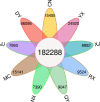Population genomics and phylogeography of Colletes gigas, a wild bee specialized on winter flowering plants
- PMID: 35494503
- PMCID: PMC9035574
- DOI: 10.1002/ece3.8863
Population genomics and phylogeography of Colletes gigas, a wild bee specialized on winter flowering plants
Abstract
Diet specialization may affect the population genetic structure of pollinators by reducing gene flow and driving genetic differentiation, especially in pollen-specialist bees. Colletes gigas is a pollen-specialist pollinator of Camellia oleifera, one of the most important staple oil crops in China. Ca. oleifera blooms in cold climates and contains special compounds that make it an unusable pollen source to other pollinators. Thus, C. gigas undoubtedly plays a key role as the main pollinator of Ca. oleifera, with biological and economic significance. Here, we use a population genomic approach to analyze the roles of geography and climate on the genetic structure, genetic diversity, and demographic history of C. gigas. A total of 1,035,407 SNPs were identified from a 582.77 Gb dataset. Clustering and phylogenetic analyses revealed a marked genetic structure, with individuals grouped into nine local clusters. A significant isolation by distance was detected by both the Mantel test (R = .866, p = .008) and linear regression (R 2 = .616, p < .001). Precipitation and sunshine duration were positively and significantly (R ≥ .765, p ≤ .016) correlated with observed heterozygosity (H o) and expected heterozygosity (H e). These results showed that C. gigas populations had a distinct phylogeographic pattern determined by geographical distance and environmental factors (precipitation and sunshine duration). In addition, an analysis of paleogeographic dynamics indicated that C. gigas populations exhibited patterns of glacial expansion and interglacial contraction, likely resulting from post-glacial habitat contraction and fragmentation. Our results indicated that the peculiar phylogeographic patterns in C. gigas populations may be related to their specialization under long-term adaptation to host plants. This work improves our understanding of the population genetics in pollen-specialist bees. The distinct genetic clusters identified in this study should be taken into consideration for the protection and utilization of this specialized crop pollinator.
Keywords: colletid bees; demographic history; genetic variation; population genomics; population structure; specialist pollinator.
© 2022 The Authors. Ecology and Evolution published by John Wiley & Sons Ltd.
Conflict of interest statement
The authors have no conflict of interest to declare.
Figures





Similar articles
-
The First Draft Genome of the Plasterer Bee Colletes gigas (Hymenoptera: Colletidae: Colletes).Genome Biol Evol. 2020 Jun 1;12(6):860-866. doi: 10.1093/gbe/evaa090. Genome Biol Evol. 2020. PMID: 32386319 Free PMC article.
-
Limited phenological and dietary overlap between bee communities in spring flowering crops and herbaceous enhancements.Ecol Appl. 2018 Oct;28(7):1924-1934. doi: 10.1002/eap.1789. Epub 2018 Sep 5. Ecol Appl. 2018. PMID: 30184292
-
Geographical differentiation in floral traits across the distribution range of the Patagonian oil-secreting Calceolaria polyrhiza: do pollinators matter?Ann Bot. 2014 Jan;113(2):251-66. doi: 10.1093/aob/mct239. Epub 2013 Nov 18. Ann Bot. 2014. PMID: 24252281 Free PMC article.
-
Specialist foragers in forest bee communities are small, social or emerge early.J Anim Ecol. 2019 Aug;88(8):1158-1167. doi: 10.1111/1365-2656.13003. Epub 2019 May 24. J Anim Ecol. 2019. PMID: 31063228
-
Why are there so many bee-orchid species? Adaptive radiation by intra-specific competition for mnesic pollinators.Biol Rev Camb Philos Soc. 2020 Dec;95(6):1630-1663. doi: 10.1111/brv.12633. Epub 2020 Sep 21. Biol Rev Camb Philos Soc. 2020. PMID: 32954662 Review.
Cited by
-
The impact of geography and climate on the population structure and local adaptation in a wild bee.Evol Appl. 2023 May 8;16(6):1154-1168. doi: 10.1111/eva.13558. eCollection 2023 Jun. Evol Appl. 2023. PMID: 37360027 Free PMC article.
-
Evolutionary Adaptation of Genes Involved in Galactose Derivatives Metabolism in Oil-Tea Specialized Andrena Species.Genes (Basel). 2023 May 22;14(5):1117. doi: 10.3390/genes14051117. Genes (Basel). 2023. PMID: 37239477 Free PMC article.
-
Ecological Interactions Between Camellia oleifera and Insect Pollinators Across Heterogeneous Habitats.Insects. 2025 Mar 8;16(3):282. doi: 10.3390/insects16030282. Insects. 2025. PMID: 40266747 Free PMC article.
-
The mechanism of Andrena camellia in digesting toxic sugars.iScience. 2024 Apr 29;27(6):109847. doi: 10.1016/j.isci.2024.109847. eCollection 2024 Jun 21. iScience. 2024. PMID: 38840840 Free PMC article.
References
-
- Allendorf, F. W. , & Luikart, G. (2006). Conservation and the genetics of populations (1st ed.). Wiley‐Blackwell.
-
- Biesmeijer, J. C. , Roberts, S. P. M. , Reemer, M. , Ohlemüller, R. , Edwards, M. , Peeters, T. , Schaffers, A. P. , Potts, S. G. , Kleukers, R. , Thomas, C. D. , Settele, J. , & Kunin, W. E. (2006). Parallel declines in pollinators and insect‐pollinated plants in Britain and the Netherlands. Science, 313(5785), 351–354. 10.1126/science.1127863 - DOI - PubMed
Associated data
LinkOut - more resources
Full Text Sources

